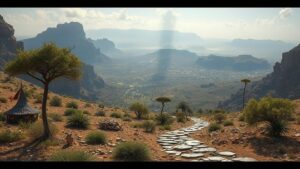Tracing the remnants of the city of Alesia, a pivotal site in Julius Caesar’s conquest of Gaul.
Tracing the Remnants of the City of Alesia
The site of Alesia, located in modern-day France, holds a significant place in history as the scene of Julius Caesars decisive confrontation during the Gallic Wars. This monumental site not only reflects military tactics of the time but also showcases the cultural and political landscape of ancient Gaul. The events that unfolded in Alesia not only led to the defeat of Vercingetorix, the Gallic leader, but also paved the way for Romes expansion into the territories of what would become modern France.
Historical Background
Alesia was strategically important in 52 BC, situated on the plateau of Mont Auxois, near the contemporary town of Alise-Sainte-Reine in Côte-dOr. Caesar’s campaign against the Gauls was fueled by his ambition to govern a unified Roman state. The culmination of hostilities led to the siege of Alesia, where Vercingetorixs forces made their last stand.
In September 52 BC, Caesar’s legions trapped Vercingetorix and his troops within the fortified settlement. Despite their desperation, the Gauls managed to call for reinforcements, leading to a dual siege situation. Caesars forces faced the daunting task of holding the perimeter while contending with an approaching relief army.
The Siege and Its Tactics
Caesars tactical ingenuity was paramount in the siege of Alesia. He constructed an extensive series of fortifications, which included:
- Double circumvallation: A series of walls that encircled Alesia, preventing escape for Vercingetorixs forces.
- Contravallation: A second set of defensive walls built to fend off the approaching Gallic reinforcements.
- Various siege engines: Catapults and ballistae were employed to breach Alesias fortifications and deter enemy advances.
These strategies exemplified the Roman military engineering capabilities and their ability to adapt under pressure. According to ancient sources, including Caesars own accounts in Commentarii de Bello Gallico, the Roman legions numbered around 60,000, while Vercingetorix held around 80,000 troops. outcome of this confrontation would define the future of Gaul.
The Outcome and Its Significance
After weeks of grueling conflict, the siege concluded in October 52 BC, with Vercingetorix surrendering to Caesar. This victory was monumental, not only leading to the solidification of Roman control over Gaul but also diminishing resistance against Roman rule. The aftermath of Alesia saw a dramatic shift in the balance of power across Europe.
Historical estimates suggest that Alesias siege cost the lives of tens of thousands of soldiers on both sides, illustrating the grave price of warfare in this era. Caesars annexation of Gaul facilitated the integration of Gallic tribes into the Roman Empire, impacting trade, culture, and governance.
Archaeological Discoveries
The historical significance of Alesia has spurred considerable archaeological interest, with excavations revealing remnants of the fortifications and artifacts from the Roman period. Sites of interest include:
- The remains of Caesar’s fortifications, providing insight into Roman military architecture.
- Artifacts such as weapons, pottery, and coinage attributed to both Roman and Gallic cultures.
- Pillars and remnants of the Roman siege engines, shedding light on the technology of the age.
In 1860, the site was officially identified, and subsequent archaeological efforts have revealed critical aspects of life and warfare in the ancient world. These findings allow modern historians and archaeologists to piece together a clearer picture of the tactical operations carried out during the siege.
Real-World Applications: Lessons from Alesia
The historical events at Alesia carry various lessons applicable today, not just in military strategy but also in politics and leadership:
- Strategic Planning: The successful execution of a multi-layered defense strategy can inform military and business planning scenarios.
- Leadership in Crisis: The ability to make decisive decisions under pressure, as demonstrated by both Caesar and Vercingetorix, is vital in any leadership role.
- Understanding Cultural Dynamics: Caesar’s approach to subduing and integrating Gallic tribes underscores the importance of cultural awareness in international relations.
Takeaways
Alesia serves as a poignant reminder of the complexities of warfare and strategy in ancient history. site reflects not only the military might of Rome but also the resilience of diverse cultures striving for freedom. The historical and archaeological remnants of Alesia continue to fascinate scholars and visitors alike, embodying the enduring legacy of this pivotal period in history.


